
4.3.3. Input connection check
After the system setup (auto-configuration) procedure is completed, you can verify the connectivity of
all sensors and binary input channels by pressing the SET
SET push-button three (3) times within two
(2) seconds. The LEDs of the corresponding sensors and binary input channels start blinking while the
"Power" LED is already blinking. The LEDs blink as many times as there are connected sensors and
binary output channels from other units.
4.4. DIP switch settings
The DIP switches are used to configure the unit's tripping logic and other functionalities. The various
trip schemes can be programmed easily by selecting the appropriate DIP switch positions, which
allows for more flexibility when changing the settings depending on the application. However, the most
convenient way to set the unit or a more complex arc protection system is to use Standard Arc
Schemes (SAS).
Tripping can be based on arc ligh only, or on both arc light and current thresholds, or on other tripping
criteria (such as undervoltage, etc.). Current threshold and other tripping criteria can also be applied to
BI1 to block tripping caused by natural light sources. The CBFP (circuit breaker failure protection)
scheme can also be enabled with the DIP switches. The DIP switch's pins 1…4 are used for selecting
schemes, and their numbering is based on binary arithmetic.
The DIP switches are located at the back of the unit for easy access. The figure below presents the DIP
switch numbering, and the table below that gives a detailed description of the settings.
Figure. 4.4. - 8. DIP switch diagram.
Table. 4.4. - 2. DIP switch settings.
Pin
number
(name)
Function selection
ON (left position)
OFF (right position)
8
(L> or
or L>
+ I>)
The tripping criterion for
the S2, S3, S4 (sensor)
and S5 (fiber) channels.
Tripping on light only (L>).
Tripping on light and overcurrent (L> + I>),
both of which are required to occur
simultaneously to trigger tripping.
7
(S1: L>
or
or L> +
I>)
The tripping criterion for
the S1 sensor channel.
Tripping on light only (L>).
Tripping on light and overcurrent (L> + I>),
both of which are required to occur
simultaneously to trigger tripping.
A
AQ
Q-101(D
-101(D)L
)LV
V
Version: 1.00
15
© Arcteq Relays Ltd
















































